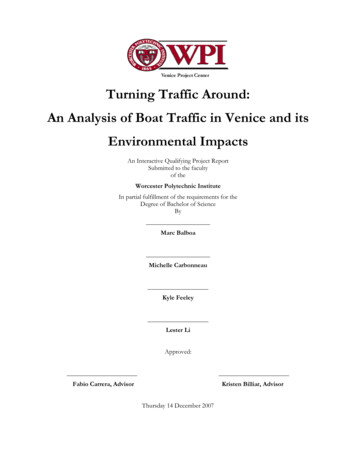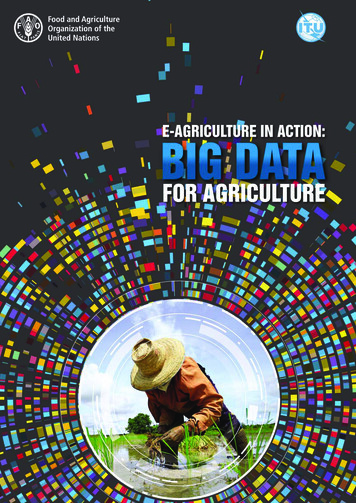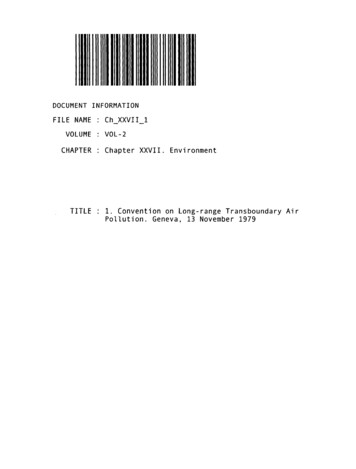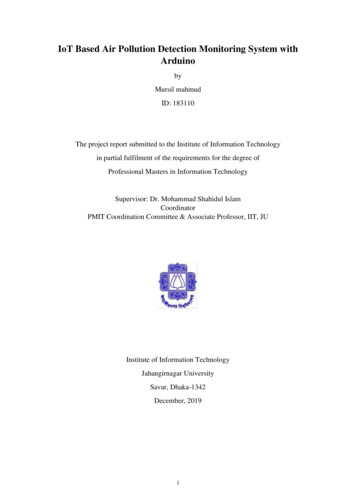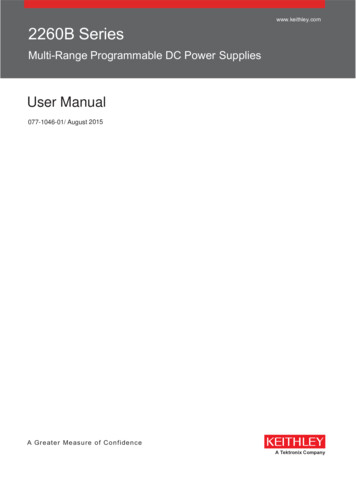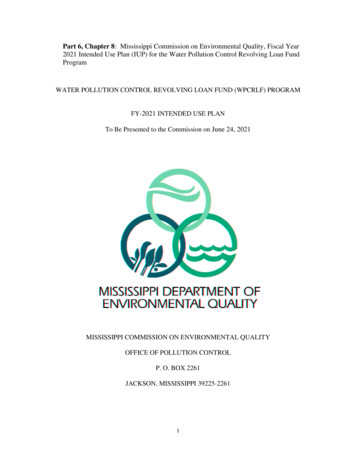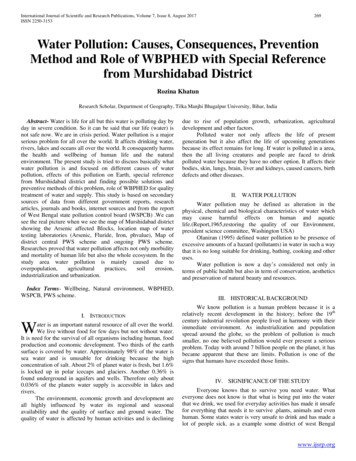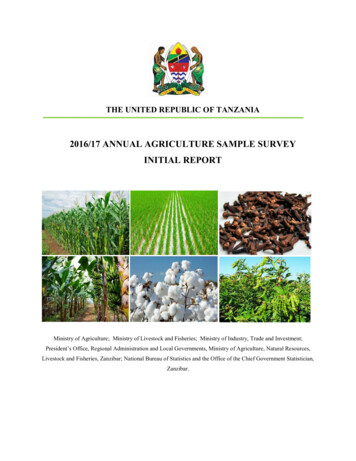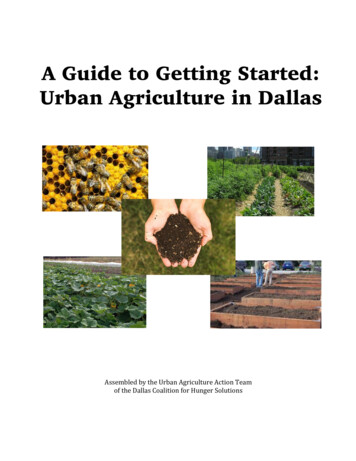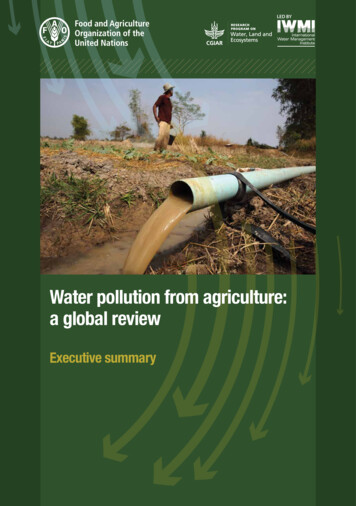
Transcription
LED BYWater pollution from agriculture:a global reviewExecutive summary
Water pollution from agriculture:a global reviewExecutive summarybyJavier Mateo-Sagasta (IWMI),Sara Marjani Zadeh (FAO)and Hugh Turralwith contributions fromJacob Burke (formerly FAO)Published bythe Food and Agriculture Organization of the United NationsRome, 2017and the International Water Management Institute on behalf ofthe Water Land and Ecosystems research programColombo, 2017
FAO and IWMI encourage the use, reproduction and dissemination of materialin this information product. Except where otherwise indicated, material maybe copied, downloaded and printed for private study, research and teachingpurposes, or for use in non-commercial products or services, provided thatappropriate acknowledgement of FAO and IWMI as the source and copyrightholder is given and that FAO’s and IWMI’s endorsement of users’ views,products or services is not implied in any way.All requests for translation and adaptation rights, and for resale and othercommercial use rights should be made via www.fao.org/contact-us/licencerequest or addressed to copyright@fao.org.FAO information products are available on the FAO website (www.fao.org/publications) and can be purchased through publications-sales@fao.org” FAO and IWMI, 2017Cover photograph: Jim Holmes/IWMI
Neil Palmer (IWMI)A GLOBAL WATER-QUALITY CRISISAND THE ROLE OF AGRICULTUREWater pollution is a global challenge that has increased in both developed anddeveloping countries, undermining economic growth as well as the physical andenvironmental health of billions of people.Although global attention has focused primarily on water quantity, water-use efficiencyand allocation issues, poor wastewater management has created serious water-qualityproblems in many parts of the world, worsening the water crisis. Global water scarcityis caused not only by the physical scarcity of the resource but also by the progressivedeterioration of water quality in many countries, reducing the quantity of water that issafe to use.1The 2030 Agenda for Sustainable Development acknowledges the importance ofwater quality and includes a specific water quality target in Sustainable DevelopmentGoal (SDG) 6.2 The 2030 Agenda for Sustainable Development is expected to strongly1 TheFood and Agriculture Organization of the United Nations (FAO) global-framework) and the International Water Management Institute (IWMI) (www.iwmi.cgiar.org) areleading agencies in combating global water scarcity by promoting state-of-the-art sustainable water managementscenarios.2SDG Target 6.3: “By 2030, improve water quality by reducing pollution, eliminating dumping and minimizing releaseof hazardous chemicals and materials, halving the proportion of untreated wastewater and substantially increasingrecycling and safe reuse globally” (United Nations, 2016).
2A GLOBAL WATER-QUALITY CRISIS AND THE ROLE OF AGRICULTUREinfluence future policies and strategies and to ensure that the control of water pollutionis elevated in international and national priorities.Human settlements, industries and agriculture3 are the major sources of waterpollution. Globally, 80 percent of municipal wastewater is discharged into water bodiesuntreated, and industry is responsible for dumping millions of tonnes of heavy metals,solvents, toxic sludge and other wastes into water bodies each year (WWAP, 2017).Agriculture, which accounts for 70 percent of water abstractions worldwide, playsa major role in water pollution. Farms discharge large quantities of agrochemicals,organic matter, drug residues, sediments and saline drainage into water bodies. Theresultant water pollution poses demonstrated risks to aquatic ecosystems, humanhealth and productive activities (UNEP, 2016).In most high-income countries and many emerging economies, agricultural pollutionhas already overtaken contamination from settlements and industries as the majorfactor in the degradation of inland and coastal waters (e.g. eutrophication). Nitratefrom agriculture is the most common chemical contaminant in the world’s groundwateraquifers (WWAP, 2013). In the European Union, 38 percent of water bodies aresignificantly under pressure from agricultural pollution (WWAP, 2015). In the UnitedStates of America, agriculture is the main source of pollution in rivers and streams,the second main source in wetlands and the third main source in lakes (US EPA,2016). In China, agriculture is responsible for a large share of surface-water pollutionand is responsible almost exclusively for groundwater pollution by nitrogen (FAO,2013). In low-income countries and emerging economies, the large loads of untreatedmunicipal and industrial wastewater are major concerns. Nevertheless, agriculturalpollution, aggravated by increased sediment runoff and groundwater salinization, isalso becoming an issue.Agricultural pressures on water quality come from cropping and livestock systems andaquaculture, which have all expanded and intensified to meet increasing food demandrelated to population growth and changes in dietary patterns. The area equipped forirrigation has more than doubled in recent decades (from 139 million hectares – Mha– in 1961 to 320 Mha in 2012; FAO, 2014) and the total number of livestock has morethan tripled (from 7.3 billion units in 1970 to 24.2 billion units in 2011; FAO, 2016a).Aquaculture has grown more than 20-fold since the 1980s, especially inland fedaquaculture and particularly in Asia (FAO, 2016b).3Agriculture refers to cropping activities, livestock and aquaculture.
Neil Palmer (IWMI)WATER POLLUTION FROM AGRICULTURE: A GLOBAL REVIEW - EXECUTIVE SUMMARY3The livestock sector is growing andintensifying faster than crop productionin almost all countries. The associatedwaste, including manure, has seriousimplications for water qualityThe global growth of crop production has been achieved mainly through the intensiveuse of inputs such as pesticides and chemical fertilizers. The trend has been amplified bythe expansion of agricultural land, with irrigation playing a strategic role in improvingproductivity and rural livelihoods while also transferring agricultural pollution towater bodies.The livestock sector is growing and intensifying faster than crop production in almostall countries. The associated waste, including manure, has serious implications forwater quality (FAO, 2006). In the last 20 years, a new class of agricultural pollutantshas emerged in the form of veterinary medicines (antibiotics, vaccines and growthpromoters [hormones]), which move from farms through water to ecosystems anddrinking-water sources. Zoonotic waterborne pathogens are another major concern(WHO, 2012).There has been a dramatic and rapid increase in aquaculture worldwide in marine,brackish-water and freshwater environments (FAO, 2016b). Fish excreta and uneatenfeeds from fed aquaculture diminish water quality. Increased production has combinedwith greater use of antibiotics, fungicides and anti-fouling agents, which in turn maycontribute to pollute downstream eco-systems.Water pollution from agriculture has direct negative impacts on human health; forexample, the well-known blue-baby syndrome in which high levels of nitrates inwater can cause methaemoglobinemia – a potentially fatal illness – in infants. Pesticideaccumulation in water and the food chain, with demonstrated ill effects on humans,led to the widespread banning of certain broad-spectrum and persistent pesticides(such as DDT and many organophosphates), but some such pesticides are still used inpoorer countries, causing acute and likely chronic health effects. Aquatic ecosystemsare also affected by agricultural pollution; for example, eutrophication caused by theaccumulation of nutrients in lakes and coastal waters has impacts on biodiversity andfisheries. Water-quality degradation may also have severe direct impacts on productive
A GLOBAL WATER-QUALITY CRISIS AND THE ROLE OF AGRICULTURE4activities, including agriculture. For example, dam siltation caused by the mobilizationof sediment due to erosion has cost many millions of dollars. Irrigation using salineor brackish water has limited agricultural production in hundreds of thousands ofhectares worldwide. In Organisation for Economic Co-operation and Development(OECD) countries alone, the environmental and social costs of water pollution causedby agriculture probably exceed billions of dollars annually (OECD, 2012a).Diagnosis, prediction and monitoring are key requirements for the management ofaquatic ecosystems and the mitigation of harmful impacts on them. If they are todesign cost-effective measures for preventing pollution and mitigating risks, managers,planners and lawmakers need to know the state of aquatic ecosystems, the nature anddynamics of the drivers and pressures that lead to water-quality degradation, andthe impacts of such degradation on human health and the environment. The sectionsbelow follow the logic of the Drivers-Pressures-State change-Impact-Response (DPSIR)framework (Figure 1) to present a summary of causes and effects of water pollution inagriculture as well as possible responses to prevent pollution and mitigate its impacts.FIGURE 1DPSIR framework for analysing water pollution in agricultureDriversGood ation growth,change in diets andincreased food demandPressuresExpansion andintensificationof agriculturePollution msEconomic activitiesStateWater qualitydegradation
5 FAO/Asim HafeezWATER POLLUTION FROM AGRICULTURE: A GLOBAL REVIEW - EXECUTIVE SUMMARYPOPULATION GROWTH, CHANGES INDIETS, AND INCREASING FOOD DEMANDThe global population is projected to reach 9.8 billion people by 2050 (UNDESA,2017) Population growth and changes in consumption patterns, including newdietary preferences (Figure 2) require the production of more (and more diverse) food.This, in turn, is driving agricultural expansion and intensification and bringing newenvironmental externalities, including impacts on water quality.Average calorie intake has increased as populations have become richer (despite thecontinuing large number of people living in absolute poverty). Diets are changing fromthose based mostly on grains and carbohydrates towards those with larger proportionsof meat, eggs, dairy, oils and other resource-intensive products (Figure 2) (FAO, 2009).Excessive consumption (which is leading to overnutrition and obesity, even in middleand low-income countries) and post-harvest losses and waste draw down scarceresources and increase environmental footprints, including the degradation of waterquality (FAO, WFP and IFAD, 2012).The need to produce more food implies an increase in land clearing for food productionand in the productivity of agricultural lands. The required rise in agricultural productioncannot continue to occur, however, at the expense of the environment, which has beenthe case in the last decades. Business as usual may be insufficient to meet growing needsand cannot be sustained.
POPULATION GROWTH, CHANGES IN DIETS, AND INCREASING FOOD DEMAND6FIGURE 2a) Past and expected global population, by developed and developing countriesb) Global food consumption patterns, 1964–2030a) World Population Growth10Billions864More developed 5200019901985198019751970196519601955019502More developed regionsb) Global Progress in Food Consumption3000Kcal/person/day2500OtherPulsesRoots & tubers20001500MeatSugarVegetable oilsOther cereals1000WheatRice50001964/66Sources: a) UNDESA 2017; b) FAO, 2009.1997/992030
7 FAO/Olivier ThuillierWATER POLLUTION FROM AGRICULTURE: A GLOBAL REVIEW - EXECUTIVE SUMMARYEXPANSION AND INTENSIFICATIONOF AGRICULTURAL SYSTEMSAgricultural systems have expanded and intensified in response to the ever-increasingdemand for food. In absolute terms, land clearing and agricultural expansion havecontributed to higher pollutant loads in water, but probably the biggest impactshave been caused by certain unsustainable patterns of agricultural intensification.The overuse and misuse of agrochemicals, water, animal feeds and drugs designedto increase productivity have resulted in higher pollution loads in the environment,including rivers, lakes, aquifers and coastal waters.The following sections review the unsustainable trajectory followed by agri-foodsystems and identify hotspots where crop production, livestock and aquaculture maybe the key contributors to the degradation of water quality.Cropping systemsThe world population doubled between about 1970 and 2015, but the productionof cereals almost tripled, the production of vegetables increased fourfold, tomatoproduction increased fivefold and soybean production increased eightfold (FAO,2016a). This huge increase in production was achieved through the expansion ofagricultural land, the introduction of new crop varieties, and the more intensive use ofagrochemicals and agrotechnologies.
EXPANSION AND INTENSIFICATION OF AGRICULTURAL SYSTEMS8Total mineral fertilizer consumption in major world regions, global cereal andmeat production, and per capita meat consumption, 3197019671961196405000Regional fertilizerconsumptionAsiaSouth AmericaNorth AmericaMeat & cereal productionFertilizer consumption (Mt N)& Meat consumption (kg/cap)FIGURE 3OceaniaAfricaEurope (excl. East)East EuropeGlobal productproductionMeat (100 kton)Cereal (1000 kton)Average productconsumptionMeat (kg/cap)Source: Sutton et al., 2013.Irrigation is a major factor in agricultural intensification. Big irrigation projectshave been important means for increasing food security globally and particularly indeveloping countries. Nevertheless, irrigation and drainage have often been associatedwith a loss of water quality caused by salt, pesticides and fertilizer runoff and leaching.Mineral fertilizers have been used since the nineteenth century to supplement naturalnutrient sources and recycling to raise crops and animals, but the use of such fertilizershas increased dramatically in recent decades (Figure 3). Today, the world consumesten times more mineral fertilizer than it did in the 1960s (FAO, 2016a). Rockström etal. (2009) suggested that the mobilization of nutrients could already have exceededthresholds that will trigger abrupt environmental change in continental-to-planetaryscale systems. Fertilizer use has not grown evenly worldwide. Major disparities existbetween those parts of the world with too many nutrients and those with insufficient.Key regions where excess nutrients are being transferred to water bodies include NorthAmerica, Europe, and parts of South and East Asia.In the trajectory of land-use intensification, countries have increasingly adopted apest management approach based on the use of synthetic pesticides. Today, pesticideproduction is a multibillion dollar industry, with the global market worth more thanUSD 35 billion per year (nominal) (Figure 4; FAO, 2016). Several upper-middle-
WATER POLLUTION FROM AGRICULTURE: A GLOBAL REVIEW - EXECUTIVE SUMMARYFIGURE 49Value of global pesticide trade, 1970–201435US 974197219700Source: FAO, 2016income countries (e.g. Argentina, Brazil, Malaysia, South Africa and Uruguay) andlower-middle-income countries (e.g. Cameroon, Cape Verde, Nicaragua, Pakistan andUkraine) have experienced double-digit growth in the intensity of pesticide use, albeitsometimes from a low base. Costa Rica, Colombia, Japan and Mexico have the highestpesticide use intensities worldwide (Schreinemachers and Tipraqsa, 2012). In general,the proportion of herbicides in pesticide global consumption increased rapidly, whilethe proportion of fungicides and insecticides declined (Zhang, Jiang and Ou, 2011).In developing countries, the fast rate of growth in pesticide use, reliance on broadspectrum pesticides, weak institutional frameworks, weak rule enforcement, andlimited knowledge and awareness among farmers on the use of hazardous chemicalspose enormous challenges to the safe and sustainable management of pesticides.Livestock productionLivestock production accounts for 70 percent of all agricultural land and 30 percent ofthe land surface of the planet. The livestock sector is one of the top three contributorsto the most serious environmental problems, including water-quality degradation, atevery scale from local to global (FAO, 2006).Demand for and the production of livestock products are increasing rapidly globally,but the following regions take centre stage: central and eastern United States of America;southern Brazil, Uruguay and northern Argentina; Europe; India; and China.
10EXPANSION AND INTENSIFICATION OF AGRICULTURAL SYSTEMSThe major structural changes occurring in the livestock sector are associated with thedevelopment of industrial and intensive livestock production systems, which ofteninvolve large numbers of animals concentrated in relatively small areas. Intensivelivestock systems increasingly depend on feed concentrates that are traded domesticallyand internationally. These changes are exerting growing pressure on the environmentand particularly on water quality. Most of the water used for livestock drinkingand servicing returns to the environment in the form of liquid manure, slurry andwastewater. Livestock excreta contain considerable quantities of nutrients, oxygendepleting substances and pathogens and, in intensive systems, also heavy metals, drugresidues, hormones and antibiotics. When livestock is concentrated, the associatedproduction of wastes tends to go beyond the buffering capacity of surroundingecosystems, thereby polluting surface waters and groundwater.Aquaculture productionDemand for fish and shellfish for food, feed and other products has grown faster thanfor any other agricultural commodity in the last several decades. Wild fish catchesplateaued in the 1990s and all increases in fish production, therefore, have derived fromaquaculture, which has expanded dramatically and now produces nearly half the totalquantity of fish consumed. Total global aquatic animal production reached 167 milliontonnes in 2014 (FAO, 2016b), of which an estimated 146 million tonnes was consumeddirectly by humans.Overwhelmingly, the growth of aquaculture has taken place in developing countries,which produce 91 percent of global output; the greatest concentration of aquacultureis in low-income developing nations. Asia is by far the larger producer of aquaculturaloutput, with almost 90 percent of world production, with output from China dominatingat 45.5 million tonnes per year (FAO, 2016b).There has also been a steady increase in the proportion of fed species in aquaculture thatrequire externally produced foods; this form of production accounts for 70 percent oftotal production, compared with 50 percent in 1980. Fed and intensive aquaculture canresult in export of faeces, uneaten feed and drugs to water bodies. Carnivorous speciesare of high value in aquaculture, and these require large inputs of fishmeal and otherpelleted feeds. Many types of non-fed aquaculture (e.g. mussel farming) can filter andclean waters, but other types (e.g. intensive caged crab culture) may disrupt naturalnutrient cycles and result in the degradation of water quality.Market pressures and differentiation are increasing the intensity of production andleading to increased concentrations of single species. These trends have resulted in anincrease in the use of medicines (e.g. antibiotics, fungicides and anti-fouling agents),which in turn contribute to downstream pollution.
11Hamish John Appleby (IWMI)WATER POLLUTION FROM AGRICULTURE: A GLOBAL REVIEW - EXECUTIVE SUMMARYAGRICULTURAL POLLUTANTS:SOURCES AND EFFECTSMajor agricultural contributors to water pollution (and the main targets for waterpollution control) are nutrients, pesticides, salts, sediments, organic carbon, pathogens,metals and drug residues. Table 1 shows the relative contributions of these to waterquality degradation. The importance of different forms of agricultural pollution varieswith individual situations, and negative impacts such as eutrophication (which mayinclude sediments, nutrients and organic matter) arise from combinations of stressors.NutrientsIn crop production, water pollution from nutrients occurs when fertilizers are applied ata greater rate than they are fixed by soil particles or exported from the soil profile (e.g.by plant uptake or when they are washed off the soil surface before plants can take themup). Excess nitrogen and phosphates can leach into groundwater or move via surfacerunoff into waterways. Phosphate is not as soluble as nitrate and ammonia and tends toget adsorbed onto soil particles and enter water bodies thorough soil erosion.In livestock production, feedlots are often located on the banks of watercourses so that(nutrient-rich) animal waste (e.g. urine) can be released directly into those watercourses.Manure is usually collected for use as organic fertilizer, which, if applied in excess, willlead to diffuse water pollution. In many cases, too, manure is not stored in contained
AGRICULTURAL POLLUTANTS: SOURCES AND EFFECTS12TABLE 1 Categories of major water pollutants in agriculture and therelative contributions of the three main agricultural production e contribution by:CropsLivestockAquacultureNutrientsPrimarily nitrogen and phosphoruspresent in chemical and organic fertilizersas well as animal excreta and normallyfound in water as nitrate, ammonia orphosphate*******PesticidesHerbicides, insecticides, fungicidesand bactericides, includingorganophosphates, carbamates,pyrethroids, organochlorine pesticidesand others (many, such as DDT, arebanned in most countries but are stillbeing used illegally and persistently)***--SaltsE.g. ions of sodium, chloride, potassium,magnesium, sulphate, calcium andbicarbonate. Measured in water, eitherdirectly as total dissolved solids orindirectly as electric conductivity*****SedimentMeasured in water as total suspendedsolids or nephelometric turbidity units– especially from pond drainage duringharvesting*******Organic matterChemical or biochemical oxygendemanding substances (e.g. organicmaterials such as plant matter andlivestock excreta), which use updissolved oxygen in water when theydegrade******PathogensBacteria and pathogen indicators. E.g.Escherichia coli, total coliforms, faecalcoliforms and enterococci*****MetalsE.g. selenium, lead, copper, mercury,arsenic and manganese***EmergingpollutantsE.g. drug residues, hormones and feedadditives-*****
WATER POLLUTION FROM AGRICULTURE: A GLOBAL REVIEW - EXECUTIVE SUMMARY13areas and, during significant rainfall events, it can be washed into watercourses viasurface runoff.In fed aquaculture, nutrient loads delivered to water bodies are primarily a functionof feed composition and feed conversion (faecal wastes). Uneaten feed in intensive fedaquaculture can be a significant contributor to nutrient loads in water.Together with other stressors, high nutrient loads can cause the eutrophication of lakes,reservoirs, ponds and coastal waters, leading to algae blooms that suppress otheraquatic plants and animals. Despite data gaps, 415 coastal areas have been identifiedworldwide as experiencing some form of eutrophication, of which 169 are hypoxic(WRI, 2008). The excessive accumulation of nutrients may also increase adverse healthimpacts, such as blue-baby syndrome, due to high levels of nitrate in drinking-water. FAO/Buletin Dorin GoianPesticidesMillions of tonnesof active pesticideingredients are used inagriculture each yearInsecticides, herbicides and fungicides are applied intensively in agriculture in manycountries (Schreinemachers and Tipraqsa, 2012). When improperly selected andmanaged, they can pollute water resources with carcinogens and other toxic substancesthat can affect humans. Pesticides may also affect biodiversity by killing weeds andinsects, with negative impacts up the food chain. In developed countries, althoughconsiderable use of older broad-spectrum pesticides persists, the trend is towardsthe use of newer pesticides that are more selective and less toxic to humans and theenvironment and which require lower quantities per unit area to be effective.Nevertheless, millions of tonnes of active pesticide ingredients are used in agriculture(FAO, 2016a). Acute pesticide poisoning causes significant human morbidity andmortality worldwide – especially in developing countries, where poor farmers often usehighly hazardous pesticide formulations.
AGRICULTURAL POLLUTANTS: SOURCES AND EFFECTS14SaltsThe production of brackish drainage and leaching water in agriculture has grownproportionally with the increase in irrigation in recent decades.Irrigation can mobilize salts accumulated in soils (leaching fractions), which arethen transported by drainage water to receiving water bodies and cause salinization.Excessive irrigation can also raise water tables from saline aquifers and increase theseepage of saline groundwater into watercourses. The intrusion of saline seawater intoaquifers – frequently the result of excessive groundwater extractions for agriculture –is another important cause of salinization in coastal areas (Mateo-Sagasta and Burke,2010).A. GandolfiMajor water-salinity problems have been reported inArgentina, Australia, China, India, the Sudan, theUnited States of America, and many countries in CentralAsia (FAO, 2011). In 2009, approximately 1.1 billionpeople lived in regions that had saline groundwater atshallow or intermediate depths (IGRAC, 2009).Whenever salinityincreases, thebiodiversity ofmicroorganisms,algae, plants andanimals declinesHighly saline waters alter the geochemical cyclesof major elements – such as carbon, iron, nitrogen,phosphorus, silicon and sulphur (Herbert et al., 2015)– with overall impacts on ecosystems. Salinization canaffect freshwater biota by causing changes within speciesand in community composition and can ultimately leadto biodiversity loss and migration. In general, whensalinity increases, the biodiversity of microorganisms,algae, plants and animals declines (Lorenz, 2014).SedimentsUnsustainable land use and improper tillage and soil management in agriculture areincreasing erosion and sediment runoff into rivers, lakes and reservoirs, with massivequantities of soil lost and transported to water bodies every year. The global rate oferosion in croplands is estimated at 10.5 megagrams (Mg) per ha per year, whichcorresponds to 193 kilograms of soil organic carbon per ha per year. Estimates forpastureland are lower, at 1.7 Mg per ha per year, which is equivalent to 40.4 kilogramsof soil organic carbon per ha per year. It is estimated that 43 percent of the agriculturalsediment flux is in Asia (Doetterl, Van Oost and Six, 2012).
WATER POLLUTION FROM AGRICULTURE: A GLOBAL REVIEW - EXECUTIVE SUMMARY15High rates of erosion occur in areas where precipitation is high, slopes are steepand vegetation cover is poor. Erosion is aggravated by overgrazing in pasturelands,by inappropriate ploughing on steep slopes and, more broadly, by deforestation,landclearing and the degradation of riverine vegetation.Sediment in river systems is a complex mixture of minerals and organic matter,potentially including physical and chemical pollutants. Sediments can cover anddestroy fish spawning beds, clog fish gills, and reduce useful storage volume inreservoirs. Sedimentation can damage watercourses, choke streams and make filtrationnecessary for municipal and irrigation water supplies. It can also affect delta formationand dynamics and limit the navigability of water bodies.Particles of clay and silt in sediment can adsorb many types of chemicals on theirsurfaces, including nutrients, heavy metals and persistent organic pollutants. Sediment,therefore, is a key means by which such pollutants are transported to water bodies.Organic matterOrganic matter from animal excreta, uneaten animal feed, animal-processing industriesand mismanaged crop residues are all significant water pollutants. Livestock-relatedwastes have among the highest biological oxygen demand (BOD). For example, theBOD of pig slurry is in the range of 30 000–80 000 milligrams per litre, comparedwith the typical BOD of domestic sewage of 200–500 milligrams per litre (FAO, 2006).Locally, aquaculture can be a major contributor to organic loads in water. In Scotland,for example, the discharge of untreated organic waste from salmon production isequivalent to 75 percent of the pollution discharged by the human population. Shrimpaquaculture in Bangladesh generates 600 tonnes of waste per day (SACEP, 2014).The global rate of erosion in croplandsis estimated at 10.5 megagrams (Mg)per ha per year, which corresponds to193 kilograms of soil organic carbonper ha per year FAO/Rhodri Jones / FAOOrganic matter consumes dissolved oxygen in water as it degrades, contributingstrongly to hypoxia in water bodies. The discharge of organic matter also increases therisk of eutrophication and algal blooms in lakes, reservoirs and coastal areas.
16AGRICULTURAL POLLUTANTS: SOURCES AND EFFECTSLivestock excreta contain many zoonotic microorganisms and multicellular parasitesthat can be harmful to human health.Pathogenic microorganisms can be waterborneo rfood-borne (the latter especially if the food hasbeen irrigated with contaminated water). Somepathogens can survive for days or weeks inthe faeces discharged onto land and may latercontaminate water resources via runoff (FAO,2006; WHO, 2012).Pathogens from livestock that are detrimentalto public health include bacteria such asCampylobacter spp., Es
the second main source in wetlands and the third main source in lakes (US EPA, 2016). In China, agriculture is responsible for a large share of surface-water pollution and is responsible almost exclusively for groundwater pollution by nitrogen (FAO, 2013). In low-income countries and emerging economies, the large loads of untreated
